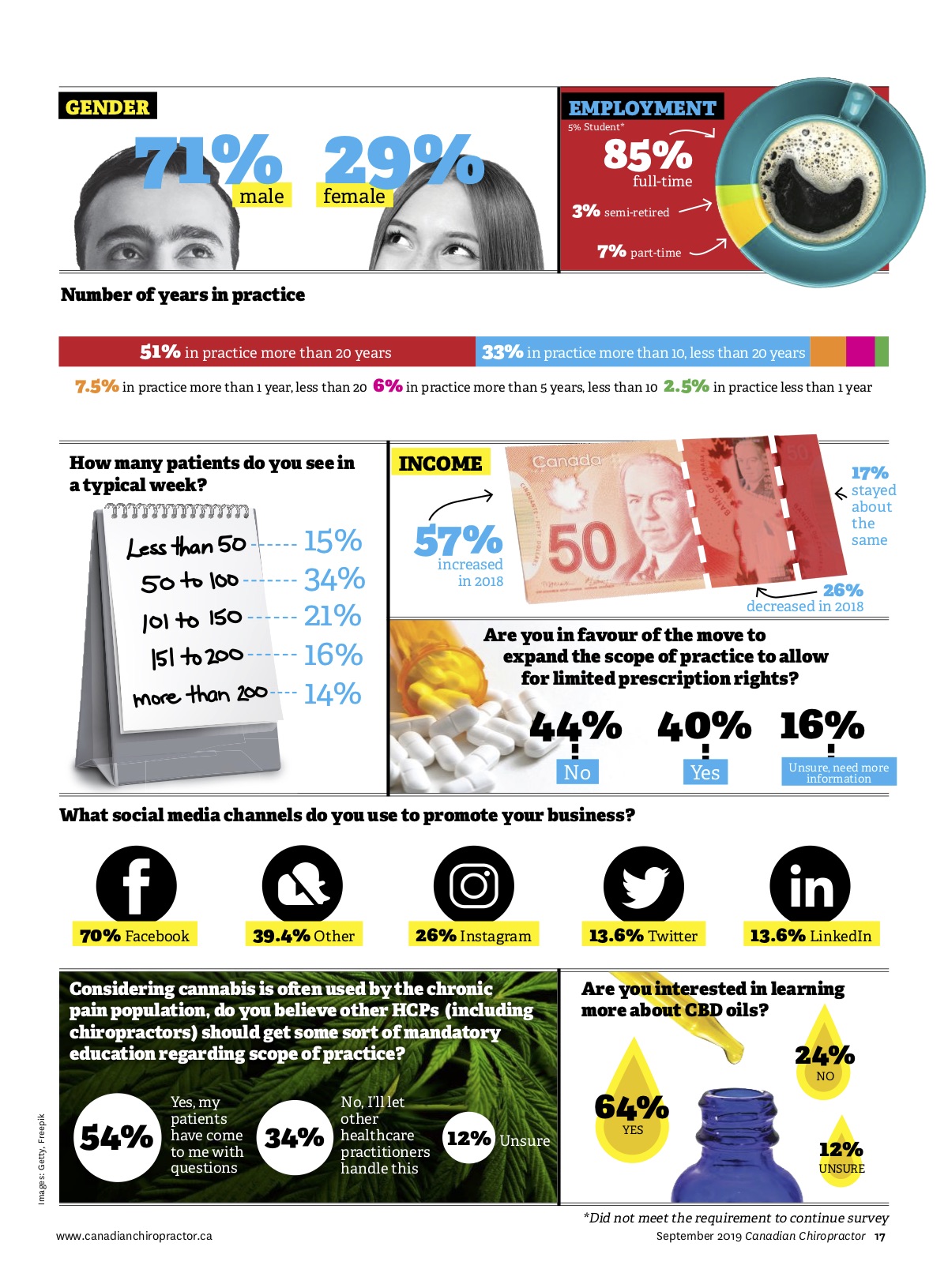
More of the same? Results of Canadian Chiropractor’s 4th annual Chiropractic Trends Survey
By Canadian Chiropractor staff
Features ProfessionA look at the results from our annual Chiropractic Trends Survey
 Photo: Adobe Stock
Photo: Adobe StockAlthough we can’t by any means extrapolate these survey results from the couple hundred responses we obtained to the entirety of the profession, survey results like these can help facilitate discussion, moving chiropractic forward.
Here’s what we learned from this year’s survey.
Case management and earnings
Just over half (51%) of respondents have been in practice for over 20 years, while those who have practised for less than 10 years was about 16%. The remainder have been practising between 10 and 20 years.
As with other years, about 50% of respondents practice in Ontario, followed closely by British Columbia (21.5%), and Alberta (10.5%). Working in a multidisciplinary clinic with complementary health care providers (RMT, naturopath, etc), was once again the top choice for chiros in Canada, although female chiropractors were more likely than their male counterparts to work in these environments. Males were more likely to work as solo practitioners. Those in their 20s and 30s were also more likely to work in multidisciplinary clinics with other medical practitioners (MDs, physiotherapists) than the older cohort. In general, chiropractors working within clinics with other medical practitioners (MDs) have nearly doubled this year (10% of total responses) compared to previous surveys.
Most in this younger cohort report their net annual earnings in 2018 between $25,000 and $99,999. The majority of this age group spent 21-30 hours in clinical practice, seeing 50-100 patients per week. Chiropractors in their 40s, 50s and 60s were more than twice as likely to work in a solo practice than those younger than 40 years of age. The bulk of this age group reported net annual earnings between $75,000 to $124,999, spending between 21-40 hours per week in clinical practice, and seeing 50-100 patients per week. Earning supplemental income from product sales was the most popular choice among all chiropractors, but those younger than 40 were more likely to have no other supplemental income.
Scope of practice, cannabis education + Biggest challenge
More chiropractors are dismissing the idea of expanding the scope of practice to include limited prescription rights. Here are a few comments:
- Chiropractic has been a drugless profession for over a hundred years. If we change that now, we are essentially negating the tremendous benefit of the chiropractic adjustment. A limited scope of prescription rights will never stay limited. Too many doctors will too quickly run to the quick fix of a prescription when it takes longer to help a person through the structural changes necessary to improve their condition. I feel that this step will be the first in the gradual decline of this profession.
- I think there is value to adding certain pain management prescription products.
- Newer graduates from most chiropractic colleges are already being trained to be second-rate physiotherapists rather than first-rate chiropractors. Why would we want to also train them to become second-rate MDs?
- I’m in agreement about expanding our scope of practice to include limited prescription rights and lab testing, but feel as though many chiropractors (including myself) would benefit from additional training regarding these privileges. Also, these expanded roles would need to be closely monitored for several months or years to ensure they were not being abused.
- Chiropractors seem to always miss the point that “prescription rights” also means the ability to talk about medications with patients. If we had this in our scope of practice, we could have legitimate, above-the-board conversations with patients and their other healthcare professionals. The “chiropractors will just start prescribing drugs and stop adjusting” arguments are orthodoxical scaremongering.
This year we asked questions concerning the areas of CBD/cannabis, seeing as it has was approved for sale in the country in October of last year. Edibles and drinkables are on track to go on sale in October of this year. (Although it looks like Quebec is opting out.) It seems chiropractors in Canada are interested to learn more about what’s happening with research surrounding cannabis (“it would be helpful to have some education on the subject”), although many commented it shouldn’t be mandatory. But, there’s interest there. As one chiropractor said “It’s our responsibility to know about cannabis just as much as we need to know about pain, anti-inflammatory, and muscle relaxing drugs.”
For the fourth year running, low trust level from the public was once again selected as the biggest challenge to the profession (22%), followed closely by “other” (21%) where DCs listed a variety of gripes. This year, “high cost of running my practice” slid into third-place as the biggest challenge. Some of the gripes listed in the “other” category were also within the answer choices, but this question always elicits additional commentary. Mostly chiros were commenting on the in-fighting and “internal attacks” with the profession. A few said it’s these reasons specifically why there’s a low trust level from the public or medical community and bad PR/public perception. There was a lot of concern as well that the pure MSK focus is a danger to the profession in that the public sees chiropractors as “glorified physiotherapists.” One DC said that for the public, there is a “lack of understanding about how [chiropractors] can help.”

Satisfaction with associations
New this year, Canadian Chiropractor asked a new open-ended question to survey respondents: Do you believe the provincial and national associations are doing enough to support the profession in Canada? Why or why not?
Over half (55%) said “no,” 32% said “yes,” while 13% were unsure, or felt “so-so” about their efforts. Below are a few of your responses. Would you agree with the consensus?
“YES”
- With the diverse philosophy within the profession, it’s challenging to keep everyone happy and still maintain a unified profession.
- We need to weed out the “bad apples” that create a negative image of profession through unethical and unprofessional practice styles and behaviour regardless of their philosophy. Also, keep truly vitalistic/philosophical chiropractors within scope of practice to better unify the profession around what we all do versus what we disagree on.
- Focused marketing and integration with hospital services.
- This is much better than 15 years ago! I think both [associations] are doing well…but it’s a big mountain to move.
“NO”
- There has been no increase in the percentage of the public using chiropractic services.
- National and provincial associations are not on the same page – cause division.
- They are promoting a narrowing of the public understanding of chiropractic and in-fighting within the profession. [They] appear to be branding us as purley MSK, which makes us no different than RMTs, physios, etc.
- Media presence has been slim to none and there is barely any communication with associations except for elections and awards. There is no public media presence for chiropractic….
“SO-SO”
- I’m moderately satisfied. The effort is fine but misguided in terms of “pain focused” messaging. I’ve been told for 27 years that the messaging has to be back pain to bring patients in and I still don’t buy it. I would much prefer our marketing be about the nerve system optimization and improving health expression.
- I think I pay them a lot of money for random campaigns that only chiropractors end up seeing.
- They are doing as much as they can with the resources they have.
- It can always be better: Evident by the low public utilization rate.
Print this page